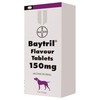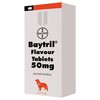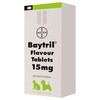Baytril Flavoured Tablets
Baytril Flavoured Tablets are indicated for the treatment of bacterial infections of the alimentary respiratory and urogenital tracts, skin, secondary wound infections and otitis externa where clinical experience, supported where possible by sensitivity testing of the causal organism, indicates enrofloxacin as the drug of choice in cats and dogs.
Baytril Tablets are presented as round tablets that are light brown to brown in colour that is slightly marbled. They have been given an artificial beef flavour for greater palatability.
Baytril 150mg Flavoured Tablets for Dogs
£3.14Baytril 150mg Flavoured Tablets are for the treatment of bacterial infections of the alimentary, respiratory and urogenital tracts, skin, secondary wound infections and otitis externa in...[More info]
Baytril 50mg Flavoured Tablets for Dogs
£1.49Baytril 50mg Flavoured Tablets are for the treatment of bacterial infections of the alimentary, respiratory and urogenital tracts, skin, secondary wound infections and otitis externa in...[More info]
Baytril 15mg Flavoured Tablets for Cats and Dogs
£0.98Baytril 15mg Flavoured Tablets are for the treatment of bacterial infections of the alimentary, respiratory and urogenital tracts, skin, secondary wound infections and otitis externa in...[More info]
Dosage and administration
The dosage rate of enrofloxacin is 5 mg/kg given orally once daily or as a divided dose twice daily for 3 to 10 days with or without food. Treatment may be initiated with Baytril 5% Injection or Baytril 2.5% Injection and maintained with Baytril Flavour Tablets.
The daily dose is achieved as follows:
Cats and small dogs: 1 Baytril Flavour Tablet 15 mg per 3 kg bodyweight
Medium dogs: 1 tablet Baytril Flavour Tablets 50 mg per 10 kg bodyweight
Large dogs: 1 tablet Baytril Flavour Tablets 150 mg per 30 kg bodyweight
Use during pregnancy and lactation
The product may be used safely in pregnant and lactating animals.
Contra-indications, warnings, etc
Baytril Flavour Tablets should not be used for prophylaxis.
Not for use in dogs less than 1 year of age or in exceptionally large breeds of dog with a longer growth period under 18 months of age, as articular cartilage may be affected during the period of rapid growth.
Not recommended for use in cats less than 8 weeks of age.
Do not exceed the recommended dose. In accidental overdose, vomiting, diarrhoea, and CNS/behavioural changes may occur. There is no antidote and treatment should be symptomatic.
Cats: Retinotopic effects including blindness can occur when the recommended dose is exceeded.
In target animal studies, cats have been shown to suffer ocular damage after receiving doses of more than 15 mg/kg once daily for 21 consecutive days. Doses of 30 mg/kg given once daily for 21 consecutive days have been shown to cause irreversible ocular damage. At 50 mg/kg given once daily for 21 consecutive days, blindness can occur.
Dogs: In dogs enrofloxacin may affect articular cartilage during the period of rapid growth.
Further information
Enrofloxacin is a synthetic, broad spectrum antimicrobial substance, belonging to the fluoroquinolone group of antibiotics. ATC Vet Code: QJ01MA90.
Enrofloxacin is bactericidal in action with activity against Gram positive and Gram negative bacteria and mycoplasmas. The mechanism of action of the quinolones is unique among antimicrobials – they act primarily to inhibit bacterial DNA gyrase, an enzyme responsible for controlling the supercoiling of bacterial DNA during replication. Resealing of the double standard helix is inhibited resulting in irreversible degradation of the chromosomal DNA. The fluoroquinolones also possess activity against bacteria in the stationary phase by an alteration of the permeability of the outer membrane phospholipid cell wall.
The pharmacokinetics of enrofloxacin are such that oral and parenteral administration lead to similar serum levels. Enrofloxacin possesses a high distribution volume. Tissue levels 2–3 times higher than that found in the serum have been demonstrated in laboratory animals and target species. Organs in which high levels can be expected are the lungs, liver, kidney, skin, bone, and lymphatic system. Enrofloxacin also distributes into the cerebrospinal fluid, the aqueous humour, and the foetus in pregnant animals.


